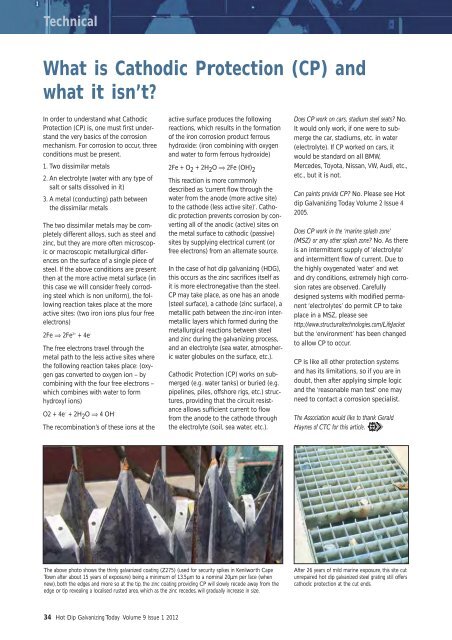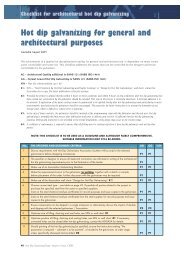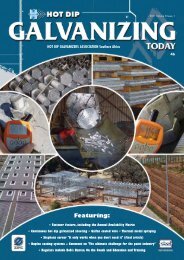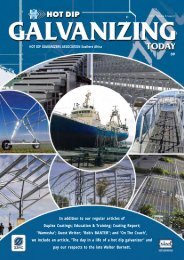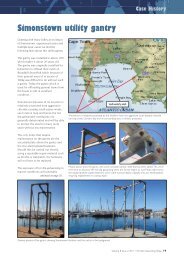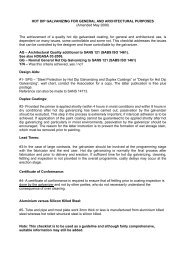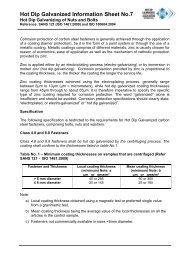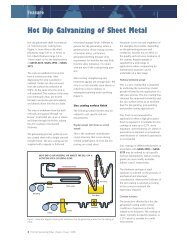Fasteners - hdgasa
Fasteners - hdgasa
Fasteners - hdgasa
Create successful ePaper yourself
Turn your PDF publications into a flip-book with our unique Google optimized e-Paper software.
Technical<br />
What is Cathodic Protection (CP) and<br />
what it isn’t?<br />
In order to understand what Cathodic<br />
Protection (CP) is, one must first understand<br />
the very basics of the corrosion<br />
mechanism. For corrosion to occur, three<br />
conditions must be present.<br />
1. Two dissimilar metals<br />
2. An electrolyte (water with any type of<br />
salt or salts dissolved in it)<br />
3. A metal (conducting) path between<br />
the dissimilar metals<br />
The two dissimilar metals may be completely<br />
different alloys, such as steel and<br />
zinc, but they are more often microscopic<br />
or macroscopic metallurgical differences<br />
on the surface of a single piece of<br />
steel. If the above conditions are present<br />
then at the more active metal surface (in<br />
this case we will consider freely corroding<br />
steel which is non uniform), the following<br />
reaction takes place at the more<br />
active sites: (two iron ions plus four free<br />
electrons)<br />
2Fe ⇒ 2Fe 2+ + 4e –<br />
The free electrons travel through the<br />
metal path to the less active sites where<br />
the following reaction takes place: (oxygen<br />
gas converted to oxygen ion – by<br />
combining with the four free electrons –<br />
which combines with water to form<br />
hydroxyl ions)<br />
O2 + 4e – + 2H 2 O ⇒ 4 OH –<br />
The recombination’s of these ions at the<br />
active surface produces the following<br />
reactions, which results in the formation<br />
of the iron corrosion product ferrous<br />
hydroxide: (iron combining with oxygen<br />
and water to form ferrous hydroxide)<br />
2Fe + O 2 + 2H 2 O ⇒ 2Fe (OH) 2<br />
This reaction is more commonly<br />
described as 'current flow through the<br />
water from the anode (more active site)<br />
to the cathode (less active site)’. Cathodic<br />
protection prevents corrosion by converting<br />
all of the anodic (active) sites on<br />
the metal surface to cathodic (passive)<br />
sites by supplying electrical current (or<br />
free electrons) from an alternate source.<br />
In the case of hot dip galvanizing (HDG),<br />
this occurs as the zinc sacrifices itself as<br />
it is more electronegative than the steel.<br />
CP may take place, as one has an anode<br />
(steel surface), a cathode (zinc surface), a<br />
metallic path between the zinc-iron intermetallic<br />
layers which formed during the<br />
metallurgical reactions between steel<br />
and zinc during the galvanizing process,<br />
and an electrolyte (sea water, atmospheric<br />
water globules on the surface, etc.).<br />
Cathodic Protection (CP) works on submerged<br />
(e.g. water tanks) or buried (e.g.<br />
pipelines, piles, offshore rigs, etc.) structures,<br />
providing that the circuit resistance<br />
allows sufficient current to flow<br />
from the anode to the cathode through<br />
the electrolyte (soil, sea water, etc.).<br />
Does CP work on cars, stadium steel seats? No.<br />
It would only work, if one were to submerge<br />
the car, stadiums, etc. in water<br />
(electrolyte). If CP worked on cars, it<br />
would be standard on all BMW,<br />
Mercedes, Toyota, Nissan, VW, Audi, etc.,<br />
etc., but it is not.<br />
Can paints provide CP? No. Please see Hot<br />
dip Galvanizing Today Volume 2 Issue 4<br />
2005.<br />
Does CP work in the ‘marine splash zone’<br />
(MSZ) or any other splash zone? No. As there<br />
is an intermittent supply of ‘electrolyte’<br />
and intermittent flow of current. Due to<br />
the highly oxygenated ‘water’ and wet<br />
and dry conditions, extremely high corrosion<br />
rates are observed. Carefully<br />
designed systems with modified permanent<br />
‘electrolytes’ do permit CP to take<br />
place in a MSZ, please see<br />
http://www.structuraltechnologies.com/LifeJacket<br />
but the ‘environment’ has been changed<br />
to allow CP to occur.<br />
CP is like all other protection systems<br />
and has its limitations, so if you are in<br />
doubt, then after applying simple logic<br />
and the ‘reasonable man test’ one may<br />
need to contact a corrosion specialist.<br />
The Association would like to thank Gerald<br />
Haynes of CTC for this article.<br />
The above photo shows the thinly galvanized coating (Z275) (used for security spikes in Kenilworth Cape<br />
Town after about 15 years of exposure) being a minimum of 13.5µm to a nominal 20µm per face (when<br />
new), both the edges and more so at the tip, the zinc coating providing CP will slowly recede away from the<br />
edge or tip revealing a localised rusted area, which as the zinc recedes, will gradually increase in size.<br />
After 26 years of mild marine exposure, this site cut<br />
unrepaired hot dip galvanized steel grating still offers<br />
cathodic protection at the cut ends.<br />
34 Hot Dip Galvanizing Today Volume 9 Issue 1 2012


